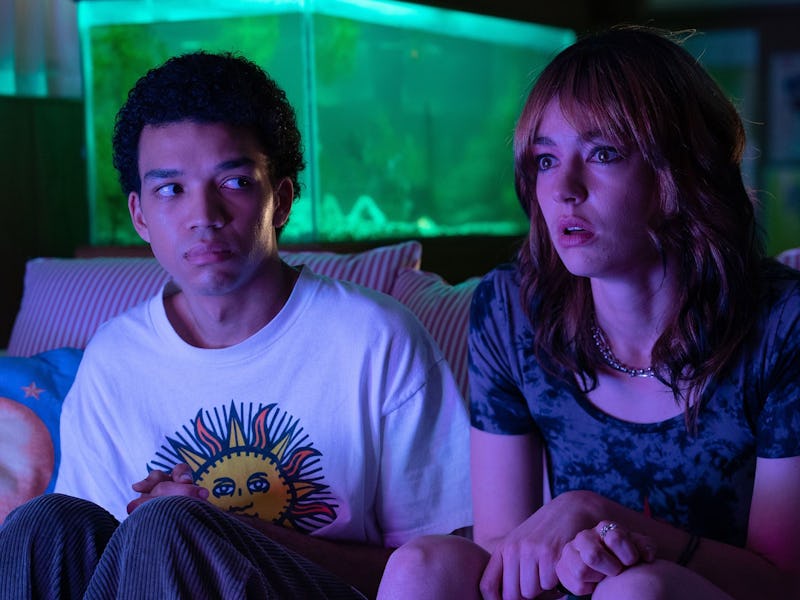I Saw the TV Glow Is a Haunting Horror Masterpiece
Director Jane Schoenbrun builds a trans allegory out of lost media and ‘90s nostalgia.

Pop culture can offer a gateway into identity. In many ways, we are what we watch, what we play, what we read — at least, that’s the idea for a generation of post-post-modern nihilists. It’s especially true for Owen (Ian Foreman), a shy seventh grader coming of age in mid-'90s suburbia, and one of the reluctant heroes of I Saw the TV Glow. He’s adrift in his idle town, alienated from his friends, and utterly alone in his own home. He stays up for as long as his curfew will allow, staring into the void of the television screen. Even there, nothing seems to connect — that is, until he stumbles across The Pink Opaque.
I Saw the TV Glow owes a lot to the hazy obsession of cult (and queer) fandom. Director Jane Schoenbrun’s second feature takes the nostalgia of pulpy prime-time TV and turns it into a primal wound. It borrows from girl-fights-monster shows like Buffy the Vampire Slayer, as well as our own collective pop culture memory, to craft a cautionary tale about the limits of “feeling seen,” especially in works of fiction. It’s haunting by turns and affirming at others, establishing Schoenbrun as an essential voice in horror.
For Owen, there is before The Pink Opaque, and there’s after. He’s properly introduced to the series through Maddy (Brigette Lundy-Paine), a gay goth girl who eats, sleeps, and breathes the series. Her love for it is infectious, but there are obstacles in place preventing Owen from following her down the rabbit hole. The Pink Opaque airs just minutes after the bedtime curfew enforced by his well-meaning mom (Danielle Deadwyler). His dad (Limp Bizkit frontman Fred Durst) wonders aloud if he should be watching “a show for girls,” one of many thinly veiled threats that push Owen right back into his shell.
Still, he can’t seem to escape The Pink Opaque — or the allure of its main character, the pensive, pretty Isabela (Helena Howard). The series follows her psychic adventures with Tara (Snail Mail’s Lindsey Jordan) as they battle monsters of the week and prepare to face the true Big Bad, Mr. Melancholy. In one of TV Glow’s cornier visual touches, he’s modeled after George Méliès’ Man in the Moon. But the threat he presents to Isabela and Tara is tangible, and just as visceral for the teens watching on the other side of the TV screen.
Maddy becomes Owen’s gateway into the series. Their relationship — if it can really be called as such — lives and dies on their shared obsession. Owen rises through the ranks of Void High School (aging into Justice Smith), but he never really grows. He tells Maddy about the nagging, hollow sensation he feels in his chest. “It feels like someone took a shovel and took out my insides,” he confesses. “It feels like there’s nothing in there... but I’m too nervous to open up and check.”
In place of courage, Owen settles for The Pink Opaque. He lives vicariously through Isabel, actively envies her — maybe even sees something of himself in her. But again, he’s too afraid to dig deeper into that inclination.
As Owen hesitates, Maddy only grows more resolute. It’s in her search for the truth that Schoenbrun unleashes their thesis — and TV Glow becomes less of an exercise in nostalgia and more urgent in its take on the trans experience. Schoenbrun describes their sophomore feature as a dramatization of the “egg crack” moment, the point “when you stop pretending you’re not trans, trying to desperately find every reason why you’re not, and admit for the first time that you are.” Their latest effort is remarkably assured and achingly personal as a result, if not a bit too reliant on metaphor. TV Glow depicts our world as a prison, a purgatory, and its two leads trapped in a limbo that may or may not be of their own making.
Owen’s coming of age is shrouded in self-denial, punctuated by pink totems and blues so deep you feel it in your bones. Every part of his world seems to be reaching out from within, pulling him toward a truth he’s not yet ready to uncover. The longer he resists, the more suffocating his reality becomes, while original anthems from Caroline Polachek and King Woman drive Schoenbrun’s surreal messaging even further into our heads.
TV Glow is daring, devastating, and best experienced cold. It’s not much of a mystery if you pay attention to the signs — and anyone who spent their formative years glued to a screen will find something to connect with here — but Schoenbrun’s latest might resonate best as a horror film. Smith commits completely to the material, and through his subdued performance, we sink deep into a life of annihilation. It’s impossible not to root for Owen, even as he makes choices that go against his best interest and he drifts further from the life he really wants.
“There is still time” is a persistent message throughout TV Glow, scrawled literally in pink and blue chalk letters on a street in Owen’s neighborhood, and embodied in Lundy-Paine’s fierce, desperate performance. As Maddy, the actor is a quiet force of nature, and a perfect fit for the unsettling story that unfolds. Its TV Glow’s central performances that suck you into this unreal world, but it's Schoenbrun’s fearless direction that makes you want to stay — no matter how squeamish its truth becomes.
I Saw the TV Glow premiered Jan. 18 at the Sundance Film Festival.
This article was originally published on